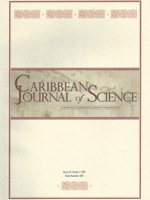We studied gas exchange, leaf dimensions, litter production, leaf and litterfall chemistry, nutrient flux to the forest floor, retranslocation rates, and nutrient use efficiency of mangroves in Jobos Bay, Puerto Rico. The fringe forest had a salinity gradient from the ocean (35‰) to a salt flat (100‰) and a basin (about 80‰). Red (Rhizophora mangle), white (Laguncularia racemosa), and black (Avicennia germinans) mangroves were zoned along this gradient. Photosynthetic rates, stomatal conductance, leaf area and weight, leaf specific area, and nutrient use efficiency decreased with increasing salinity, while xylem tension, nutrient retranslocation, and leaf respiration increased with increasing salinity. The concentration of some leaf elements increased with salinity (N, P, Mg, Na) while others decreased (Ca). Leaf specific area was less variable than leaf area or weight. Maximum photosynthesis (12.7 µmol CO2 m-2s-1), leaf conductance (283 mmol CO2 m-2s-1), and litterfall (16.9 Mg ha-1 yr-1) in the fringe were high in comparison with those of other world mangroves. Nutrient flux to the forest floor was also high and nutrient use efficiency was low in this forest. Part of the reason for these high values and low use-efficiencies was the high proportion of nutrient-rich flowers and propagules in litterfall. Nevertheless, access to freshwater in the form of groundwater discharge and about 1 m of annual rainfall play a role in the high productivity of the Jobos mangroves.
How to translate text using browser tools
1 December 2007
Ecophysiology of a Mangrove Forest in Jobos Bay, Puerto Rico
Ariel E. Lugo,
Ernesto Medina,
Elvira Cuevas,
Gilberto Cintrón,
Eddie N. Laboy Nieves,
Yara Schäeffer Novelli
ACCESS THE FULL ARTICLE

Caribbean Journal of Science
Vol. 43 • No. 2
2007
Vol. 43 • No. 2
2007




